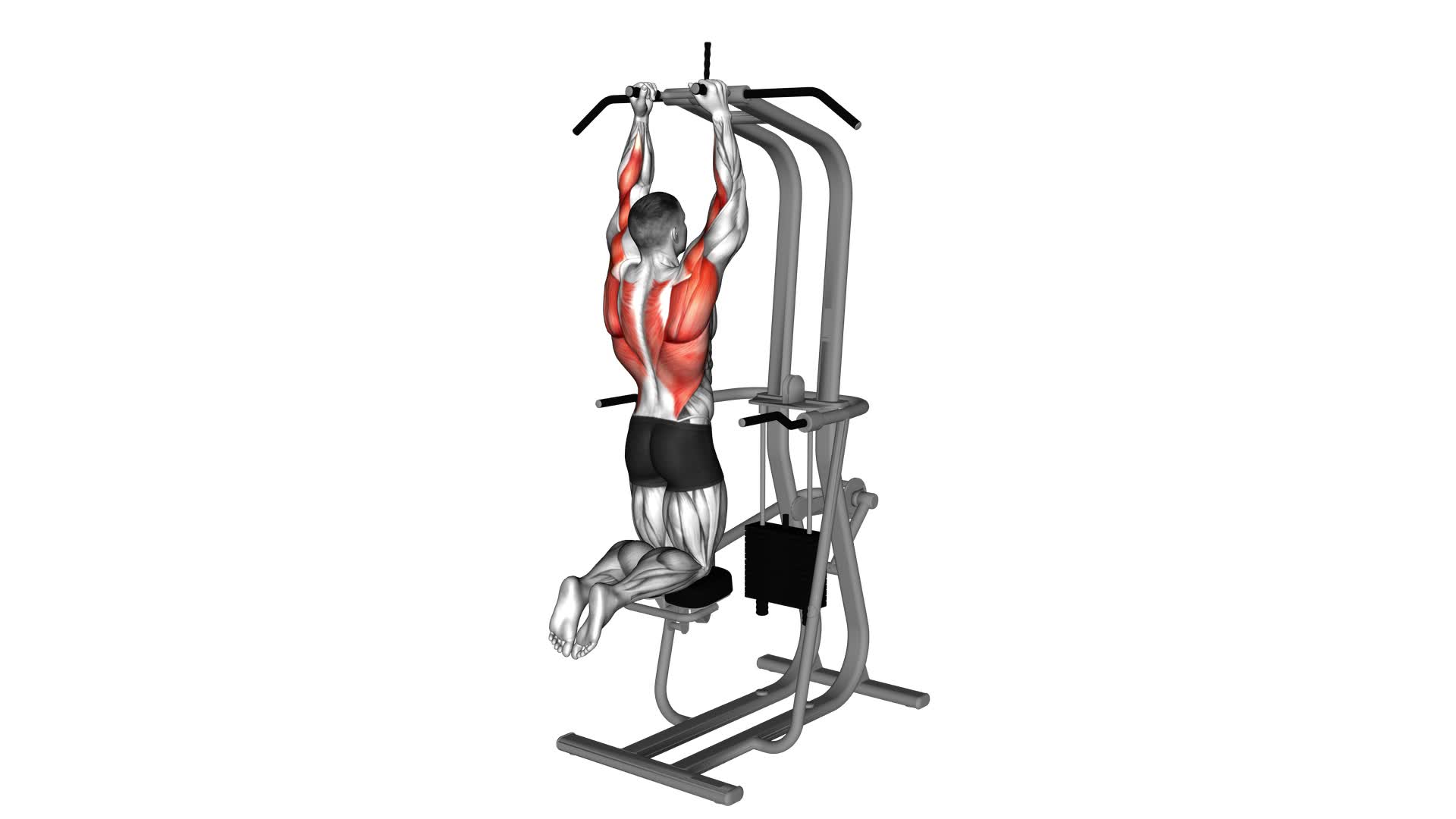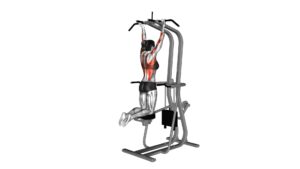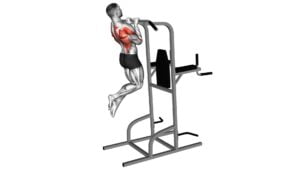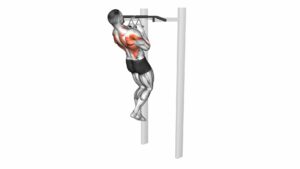Assisted Parallel Close-Grip Pull-up – Video Exercise Guide & Tips

Are you looking to develop upper body strength, but traditional pull-ups feel just out of reach? You’re not alone. Assisted Parallel Close-Grip Pull-ups are a great alternative to standard pull-ups, offering similar benefits while being more accessible for beginners and those with less upper body strength.
Watch This Exercise Video
This article will guide you through the exact steps to execute this exercise correctly, targeting the right muscles, and ensuring optimum results. Read on and let’s get stronger together!
Key Takeaways
- Assisted Parallel Close-Grip Pull-ups are a great alternative to standard pull-ups, offering similar benefits while being more accessible for beginners and those with less upper body strength.
- To perform an assisted parallel close-grip pull-up, grip the parallel bars with your palms facing each other and shoulder-width apart, engage your core muscles, use the assistance machine or a spotter to support your body weight as you lift yourself up towards the bar, pause briefly at the top position with your chin above the bar, slowly lower yourself back down to the starting position while maintaining control and proper form.
- The highlighted target muscles in an assisted parallel close-grip pull-up include the latissimus dorsi (lats), biceps brachii, and rhomboids. Other muscles that are activated during this exercise include the trapezius, forearm muscles like brachialis and brachioradialis.
Close Grip Pull-Up Overview
The Close Grip Pull-Up is a fitness classic, known for its efficacy in building upper body strength. It’s often utilized as part of a comprehensive workout regimen – from amateur enthusiasts to professional athletes – due to its versatility and the wide range of muscles it targets.
With their hands positioned closer together than in traditional pull-ups, practitioners focus mainly on different muscle groups.
The Assisted Parallel Close-Grip Pull-up variant builds upon this exercise by using an assisted pullup machine or bands. This modification helps individuals who are new to training or those looking for a less intense option.
As the name suggests, it emphasizes performing the pull-ups with a parallel grip – palms facing each other – which can further engage biceps and forearm muscles while still emphasizing latissimus dorsi activation.
The use of assistance enables exercisers at all levels to maintain correct form over longer sets thus reaping full benefits from this technique-boosting functional fitness and improving posture.
How to Perform Assisted Parallel Close-Grip Pull-Up
To perform an assisted parallel close-grip pull-up, start by setting up the necessary equipment such as a pull-up bar and assistance machine. Then, follow these step-by-step instructions: grip the parallel bars with your palms facing each other and shoulder-width apart, engage your core muscles, use the assistance machine or a spotter to support your body weight as you lift yourself up towards the bar, pause briefly at the top position with your chin above the bar, slowly lower yourself back down to the starting position while maintaining control and proper form.
Starting position and equipment needed
To perform the Assisted Parallel Close-Grip Pull-Up, you will need an assisted pull-up machine. Begin by standing on the footrests of the machine and grabbing onto the parallel handles with your palms facing each other in a close grip.
Your arms should be fully extended, and your feet should be off the ground. This is your starting position.
Make sure to adjust the weight on the machine according to your strength level and desired challenge. The closer your knees are bent, the more assistance you will have during the exercise.
Keep this in mind as you progress and aim to gradually decrease assistance over time.
Once you’re in position and ready to go, engage your core muscles and pull yourself up towards the handles until your chin is above them. Focus on using primarily your back muscles while keeping proper form throughout.
Step-by-step instructions
To perform an Assisted Parallel Close-Grip Pull-Up, start by standing on the assistance platform of the pull-up machine. Grasp the parallel handles with a close grip, palms facing each other.
Engage your back muscles and retract your shoulder blades. Slowly bend your elbows and lift yourself up towards the handles until your chin is above them. Pause briefly at the top, then lower yourself back down to the starting position with controlled movement.
Repeat for the desired number of repetitions, focusing on maintaining proper form throughout the exercise. Using controlled motion ensures maximum engagement of your target muscles and reduces reliance on momentum or assistance from other muscle groups.
Tips for proper form
Maintaining proper form is crucial when performing assisted parallel close-grip pull-ups. Start by gripping the parallel bars with your palms facing each other, keeping them shoulder-width apart.
Keep your core engaged and shoulders pulled back throughout the exercise. As you lower yourself, aim to touch your chest or chin to the bar before slowly returning to the starting position.
Avoid using momentum or swinging your body, as this can decrease the effectiveness of the exercise and potentially lead to injury. Remember to breathe steadily throughout each repetition and focus on controlled movements for optimal results.
Muscles Engaged in Assisted Parallel Close-Grip Pull-Up
During the assisted parallel close-grip pull-up, the highlighted target muscles include the latissimus dorsi (lats), biceps brachii, and rhomboids. Read on to discover other muscles activated during this exercise for a full understanding of its benefits.
Highlighted target muscles
The assisted parallel close-grip pull-up primarily targets the muscles in your back, including the latissimus dorsi and rhomboids. These are the major muscle groups responsible for pulling movements and help to strengthen and define your upper back.
Additionally, this exercise also engages your biceps brachii muscles, located in the front of your upper arm. This dual muscle activation makes the assisted parallel close-grip pull-up a great exercise for building both back and arm strength.
By incorporating this exercise into your routine regularly, you can develop a stronger upper body and improve overall muscular endurance.
Other muscles that are activated
During an Assisted Parallel Close-Grip Pull-Up, several other muscles are activated along with the targeted muscles. The latissimus dorsi, or lats, which are the largest back muscles, play a significant role in this exercise.
They help to adduct and extend the shoulder joint. Additionally, the rhomboids and trapezius muscles located between the shoulder blades also contribute to stabilizing and retracting the scapulae during each pull-up.
Moreover, the biceps brachii in your upper arms work as synergists to assist with elbow flexion. Lastly, forearm muscles such as the brachialis and brachioradialis provide stability and grip strength throughout each repetition of this exercise.
Benefits of Assisted Parallel Close-Grip Pull-Up
The assisted parallel close-grip pull-up offers increased upper body strength, improved posture, and versatility for different fitness levels. Discover the benefits of this exercise and how it can help you achieve your fitness goals.
Increased upper body strength
Performing Assisted Parallel Close-Grip Pull-Ups can greatly increase your upper body strength. This exercise specifically targets muscles in the back, arms, and shoulders, helping to build a strong and defined upper body.
By regularly incorporating this exercise into your workout routine, you will gradually develop the necessary strength to perform pull-ups without assistance. Strengthening these muscle groups also has various functional benefits such as improved posture and enhanced overall performance in other exercises that require upper body strength.
Improved posture
Proper posture is essential for overall health and wellbeing. When performing the assisted parallel close-grip pull-up, you engage several muscles that help improve your posture. The exercise targets the muscles in your back, particularly the rhomboids and lower trapezius, helping to strengthen them and promote a more upright stance.
By incorporating this exercise into your routine, you can work towards achieving better alignment of your spine and shoulders, reducing the risk of slouching or rounded shoulders. Improved posture not only enhances your appearance but also reduces strain on your neck and back muscles, leading to decreased discomfort and potential injuries in those areas.
Versatility for different fitness levels
The Assisted Parallel Close-Grip Pull-Up is a versatile exercise that can be adapted to suit different fitness levels. Whether you are a beginner or more advanced, this exercise can be modified by adjusting the amount of assistance provided by the machine or using bands.
This means that individuals with varying levels of upper body strength can effectively progress and challenge themselves over time. The ability to adjust resistance makes it an ideal exercise for anyone looking to improve their upper body strength and work towards achieving unassisted pull-ups.
Other Variations of Close Grip Pull-Ups
There are several other variations of close grip pull-ups, including machine-assisted close neutral-grip pull-ups, close grip pull-ups for biceps, and comparisons between close grip pull-ups and wide grip pull-ups, normal pull-ups, and chin-ups.
Machine-assisted close neutral-grip pull-up
Using a machine-assisted close neutral-grip pull-up is another effective variation of the close grip pull-up exercise. This machine provides assistance by counterbalancing your body weight, making it easier to perform the movement.
The close neutral-grip involves using parallel bars with palms facing each other, which can help target the muscles in your back and arms even more effectively than traditional pull-ups.
By adjusting the resistance on the machine, you can gradually decrease the assistance provided as you build strength and progress towards unassisted pull-ups.
Close grip pull-ups for biceps
Close grip pull-ups are an effective exercise that specifically targets the biceps. By using a narrow hand position on the parallel bars, you engage and activate your bicep muscles to perform the movement.
This variation of pull-ups is great for building strength and definition in your biceps, helping you achieve those coveted toned arms. Incorporating close grip pull-ups into your workout routine can be a challenging yet rewarding way to develop your upper body strength and enhance the appearance of your biceps.
Close grip pull-ups vs wide grip pull-ups
Close grip pull-ups and wide grip pull-ups are two variations of the classic pull-up exercise that target different muscles in the upper body. With close grip pull-ups, your hands are positioned closer together on the bar, engaging primarily the biceps and inner back muscles.
On the other hand, wide grip pull-ups require you to place your hands wider apart on the bar, targeting the outer back muscles along with the lats. Each variation offers its own set of benefits and can be incorporated into your workout routine for a well-rounded upper body strength training.
Close grip pull-ups vs normal pull-ups
Close grip pull-ups and normal pull-ups may seem similar, but they target different muscles in your upper body. While both exercises work your back, biceps, and shoulders, close grip pull-ups put more emphasis on your biceps and allow for a greater range of motion.
On the other hand, normal pull-ups engage your lats (latissimus dorsi) more intensely. So if you’re looking to specifically target your biceps or want a wider range of muscle activation, opt for close grip pull-ups.
If you want to primarily focus on building width in your back, regular pull-ups are the way to go.
Close grip pull-ups vs chin-ups
Close grip pull-ups and chin-ups are two popular variations of the traditional pull-up exercise that target slightly different muscle groups. While both exercises primarily work the muscles in your back, shoulders, and arms, there is a subtle difference in hand placement that changes the emphasis.
Close grip pull-ups involve bringing your hands closer together on the bar, with palms facing away from you. This places more emphasis on your biceps and forearms. On the other hand, chin-ups involve using an underhand grip with your palms facing towards you and hands shoulder-width apart or wider.
Chin-ups primarily engage your biceps and chest muscles. Choosing between close grip pull-ups or chin-ups will depend on your specific goals and preferences for targeting certain muscle groups during your workout routine.
Conclusion
Mastering the assisted parallel close-grip pull-up can greatly enhance your upper body strength and posture. With proper form and technique, you’ll target key muscles like the biceps, forearms, and back.
Whether you’re a beginner or an experienced fitness enthusiast, this exercise offers versatility for all fitness levels. Add it to your routine and watch yourself achieve new heights in your fitness journey.
FAQs
1. What are the benefits of doing an assisted parallel close-grip pull-up exercise?
An assisted parallel close-grip pull-up targets your biceps, activates forearm muscles and is a great alternative to regular pullups.
2. How does a close grip pullup compare with a wide grip or chin up?
Close grip pullups provide more bicep activation compared to wide grip ones and challenge forearms engagement differently than chin ups.
3. Can you explain the proper form for an assisted parallel close-grip pull-up?
Definitely! The video exercise guide offers detailed instructions on maintaining correct form during an assisted parallel close-grip pull-up.
4. Will my muscles get worked differently in neutralgrip vs closgrip exercises?
Yes, different types of grips like neutralgrip or closegrip in exercises like pullops target specific muscle groups in varying degrees.
5. Are there any alternatives if I struggle to do normal or even assisted exercises like this one?
Absolutely, there are various other types of bar exercises and other modified forms of traditional workouts listed in our tips that can cater to different fitness levels.

Author
Years ago, the spark of my life’s passion ignited in my mind the moment I stepped into the local gym for the first time. The inaugural bead of perspiration, the initial endeavor, the very first surge of endorphins, and a sense of pride that washed over me post-workout marked the beginning of my deep-seated interest in strength sports, fitness, and sports nutrition. This very curiosity blossomed rapidly into a profound fascination, propelling me to earn a Master’s degree in Physical Education from the Academy of Physical Education in Krakow, followed by a Sports Manager diploma from the Jagiellonian University. My journey of growth led me to gain more specialized qualifications, such as being a certified personal trainer with a focus on sports dietetics, a lifeguard, and an instructor for wellness and corrective gymnastics. Theoretical knowledge paired seamlessly with practical experience, reinforcing my belief that the transformation of individuals under my guidance was also a reflection of my personal growth. This belief holds true even today. Each day, I strive to push the boundaries and explore new realms. These realms gently elevate me to greater heights. The unique combination of passion for my field and the continuous quest for growth fuels my drive to break new ground.







